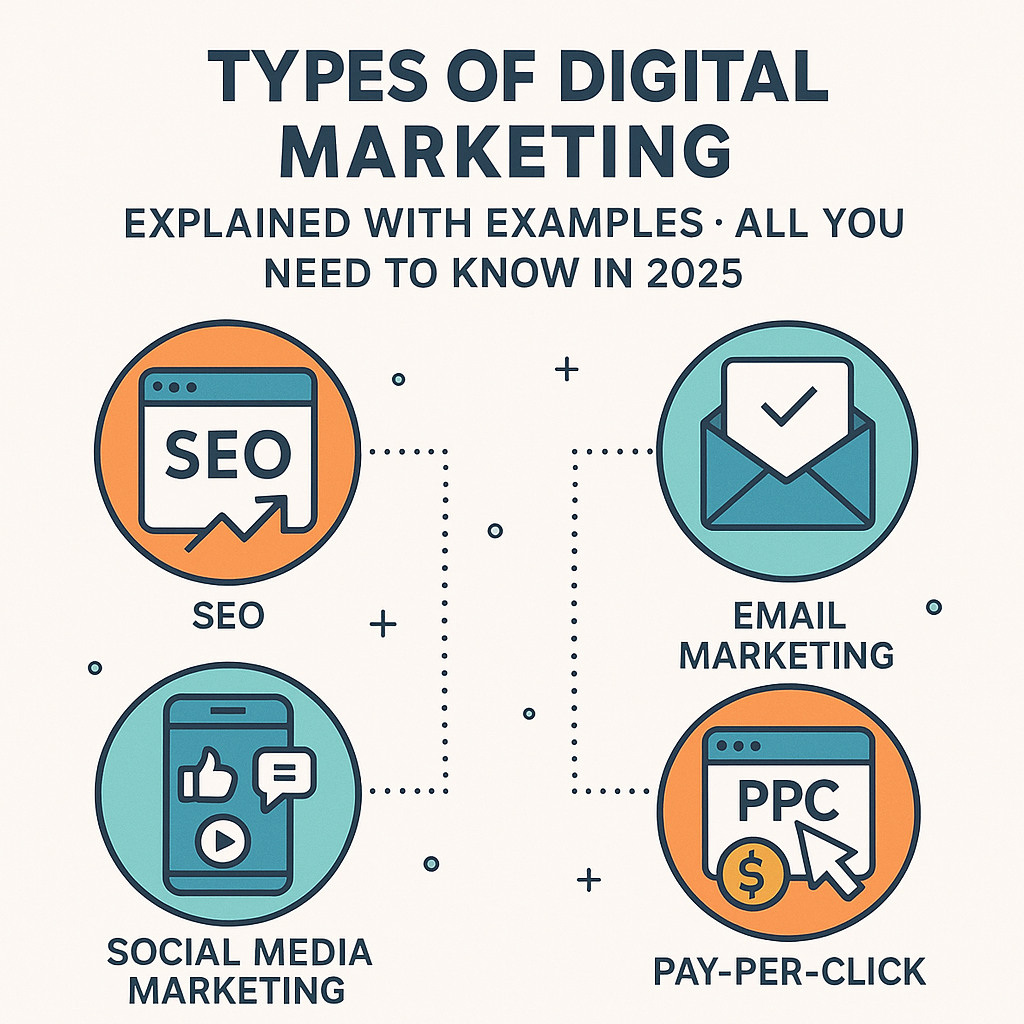Digital marketing is a mandatory step that helps businesses grow in today’s online world. Whether you own a shop, run a salon, or sell products online, marketing your business on the internet is a must in 2025.
Let’s walk through the most popular types of digital marketing; what they are, how they work, and real-life examples to help you understand each one better.
1. Search Engine Optimization (SEO)
SEO is all about helping your website show up when people search on Google. Imagine you run a bakery, and someone types “best chocolate cake near me.” If your website appears at the top, that’s because of good SEO. It includes adding the right keywords, making your website fast and mobile-friendly, and getting links from other trusted sites. It’s like giving your website a boost so search engines can notice it more easily.
2. Search Engine Marketing (SEM) / Pay-Per-Click (PPC)
SEM means paying to show up on search results. You create ads on platforms like Google Ads, and they appear when someone searches for your service. You only pay when someone clicks your ad. Simple!
For example, a cleaning company in Dubai runs ads for the keyword “home cleaning service,” and every click costs them ₹10. It’s a great way to get quick visibility when people are actively looking for what you offer.
3. Social Media Marketing (SMM)
This is using platforms like Instagram, Facebook, and LinkedIn to talk to your audience. You can post pictures, run ads, share stories, and even team up with influencers. Let’s say a fashion boutique uses Instagram Reels to showcase their latest collection. That’s SMM in action! It helps you connect directly with customers and build a loyal community around your brand.
4. Content Marketing
This type of marketing is all about creating useful content like blog posts, videos, or how-to guides. You’re not selling directly, you’re educating and attracting people to your website. Think of a fitness brand sharing workout tips on YouTube or a blog post about “Healthy Eating Habits.” It builds trust and brings in people who are interested in your topic.
5. Email Marketing
Email marketing is like talking directly to your customers through their inbox. You can send updates, offers, or reminders. For example, if someone leaves items in their cart, you can send them a gentle nudge with a “Hey, you forgot something!” email along with a small discount.
6. Affiliate Marketing
Here, you let others promote your product and pay them a small commission when they help you make a sale. For example, a blogger reviews your skincare product and adds a link. If someone buys through that link, they earn money. It’s like turning other websites and influencers into your sales team without upfront cost.
7. Influencer Marketing
Influencer marketing means partnering with people who have a strong online following. These influencers help promote your product to their fans. Imagine a popular food blogger posting about your new cafe in Kochi. It brings instant attention and trust because people follow influencers they like and believe. It’s great for launches or brand awareness.
8. Mobile Marketing
Since most people are on their phones, marketing on mobile is super important. This includes SMS offers, in-app ads, and mobile-friendly websites. For example, a grocery app might send a weekend discount via push notification. If your site or app works smoothly on a phone, people are more likely to use it and buy from you.
9. Video Marketing
Videos are fun, engaging, and easy to consume. Whether it’s a quick Instagram Reel or a YouTube tutorial, video marketing is a powerful tool. A real estate company might post house tour videos with background music and voice-over, that’s a great way to attract interested buyers. Videos grab attention and tell your story better than plain text.
10. Online Reputation Management (ORM)
ORM is about watching and improving what people say about your brand online. Responding to reviews, thanking customers, and fixing complaints quickly is key. Imagine a hotel that replies to every Google review. Good or bad, it shows they care, and that builds trust.
Conclusion
Each digital marketing method has its own strength. SEO and content help in the future, while ads and influencer marketing give faster results. The best way is to use a mix, based on your business goals and audience. Whether you run a local service in Kerala or an online store in Dubai, using these tools the right way can really grow your brand and bring in more customers.

